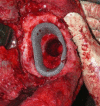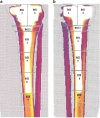Bone mineral density changes of the proximal tibia after revision total knee arthroplasty. A randomised study with the use of porous tantalum metaphyseal cones
- PMID: 22733440
- PMCID: PMC3427456
- DOI: 10.1007/s00264-012-1601-y
Bone mineral density changes of the proximal tibia after revision total knee arthroplasty. A randomised study with the use of porous tantalum metaphyseal cones
Abstract
Purpose: Forty patients were enrolled in a prospective randomised study using conventional method or "Trabecular Metal Cone" (TM Cone) (Zimmer inc., Warsaw, USA) for reconstruction of bone loss of the proximal tibia during revision total knee arthroplasty (rTKA). The aim was to evaluate changes in bone mineral density (BMD) at the proximal tibia.
Material and methods: Thirty-six patients [median 67 years (range: 40-85 years)] received rTKA with NexGen® (Zimmer Warsaw, USA) revision system. Knee Society´s Knee Scoring System and the Anderson Orthopaedic Research Institute (AORI) bone classification was used. Changes in BMD were measured by dual energy X-ray absorptiometry (DEXA).
Results: Knee and function score improved in both groups. No significant changes between the groups were found. Changes in BMD within the two groups were quite similar. Overall decreases in BMD of 0.1 - 5.4 % were found in both groups (ROI 1-6) postoperative to 12 months of follow-up, except that ROI 7 showed an increase in BMD (0.8 - 1.3 %). After 24 months of follow-up, an increase in BMD was found along the stem (ROI 2-5) of 1.9 - 6.3 % , with significant changes in the TM Cone Group (ROI 3, 4, 5) . No significant changes in BMD between the groups were found.
Conclusions: The bone remodelling pattern was almost the same in the two groups after two years.
Figures
Similar articles
-
Outcome of revision total knee arthroplasty with the use of trabecular metal cone for reconstruction of severe bone loss at the proximal tibia.Knee. 2014 Dec;21(6):1233-7. doi: 10.1016/j.knee.2014.08.017. Epub 2014 Sep 10. Knee. 2014. PMID: 25212989
-
Porous tantalum metaphyseal cones for severe tibial bone loss in revision knee arthroplasty: a five to nine-year follow-up.J Bone Joint Surg Am. 2015 Feb 4;97(3):216-23. doi: 10.2106/JBJS.N.00540. J Bone Joint Surg Am. 2015. PMID: 25653322
-
Use of porous tantalum metaphyseal cones for severe tibial bone loss during revision total knee replacement.J Bone Joint Surg Am. 2008 Jan;90(1):78-84. doi: 10.2106/JBJS.F.01495. J Bone Joint Surg Am. 2008. PMID: 18171960
-
Porous metal metaphyseal cones for severe bone loss: when only metal will do.Bone Joint J. 2014 Nov;96-B(11 Supple A):118-21. doi: 10.1302/0301-620X.96B11.34197. Bone Joint J. 2014. PMID: 25381423 Review.
-
Tantalum Cones in Revision Total Knee Arthroplasty.J Knee Surg. 2016 Nov;29(8):621-626. doi: 10.1055/s-0036-1593370. Epub 2016 Sep 20. J Knee Surg. 2016. PMID: 27648747 Review.
Cited by
-
Midterm Outcomes of Tantalum Metal Cones for Severe Bone Loss in Complex Primary and Revision Total Knee Arthroplasty.Arthroplast Today. 2021 Jan 11;7:76-83. doi: 10.1016/j.artd.2020.12.004. eCollection 2021 Feb. Arthroplast Today. 2021. PMID: 33521201 Free PMC article.
-
Does the use of 3D-printed cones give a chance to postpone the use of megaprostheses in patients with large bone defects in the knee joint?Open Med (Wars). 2022 Jul 15;17(1):1292-1298. doi: 10.1515/med-2022-0494. eCollection 2022. Open Med (Wars). 2022. PMID: 35903422 Free PMC article.
-
Densitometric evaluation of bone-prosthetic counterface in hip and knee arthroplasty with modern implants.Clin Cases Miner Bone Metab. 2016 May-Aug;13(2):144-150. doi: 10.11138/ccmbm/2016.13.2.144. Epub 2016 Oct 5. Clin Cases Miner Bone Metab. 2016. PMID: 27920813 Free PMC article.
-
Additive manufacturing of porous titanium metaphyseal components: Early osseointegration and implant stability in revision knee arthroplasty.J Clin Orthop Trauma. 2020 Oct 24;15:60-64. doi: 10.1016/j.jcot.2020.10.042. eCollection 2021 Apr. J Clin Orthop Trauma. 2020. PMID: 33717918 Free PMC article.
-
Two-stage treatment of infected total knee arthroplasty: two to thirteen year experience using an articulating preformed spacer.Int Orthop. 2014 Feb;38(2):405-12. doi: 10.1007/s00264-013-2241-6. Epub 2014 Jan 26. Int Orthop. 2014. PMID: 24464017 Free PMC article.
References
-
- Benjamin J, Engh G, Parsley B, Donaldson T and Coon T (2001) Morselized bone grafting of defects in revision total knee arthroplasty. Clin Orthop Relat Res: 62–67 - PubMed
Publication types
MeSH terms
Substances
LinkOut - more resources
Full Text Sources
Medical



